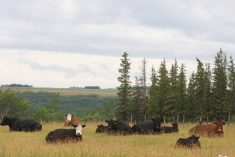A big thumbs up to the five Manitoba commodity groups that announced recently they will work towards a merger.
The Manitoba Corn Growers Association, Manitoba Pulse and Soybean Growers Association, the Manitoba Flax Growers Association, the National Sunflower Association of Canada and the Manitoba Wheat and Barley Growers Association have signed a memorandum of understanding spelling out a process for negotiations over the coming year.
- Read more: Commodity groups exploring merger
Read Also

Roundup retraction makes public trust ripples
A foundational study on glyphosate safety was recently retracted, while Roundup maker Bayer has already said it may ditch the key agricultural herbicide after lawsuits piled up.
This effort follows the lead by farm groups in the East that coalesced into Grain Farmers of Ontario, a provincial association that’s already developed a good reputation for representing growers. Closer to home, some of the groups in the current talks have already been “collaborating,” including a shared general manager in the case of the Manitoba Wheat and Barley Growers and Manitoba Corn Growers.
And why not? These groups share a common grower base. Few farmers grow just one commodity. Having stand-alone single-commodity organizations was causing rumblings that there were too many hands dipping into one farmer’s pocket just to duplicate overhead.
But there was another, more insidious risk. Commodity-specific research can only go so far when the evidence clearly shows Prairie farmers need to have a diversified crop rotation in order to succeed. Who supports the research needs of some of those secondary crops that help round out the rotation?
According to those involved in the discussion, the issue isn’t going to be reducing checkoffs, but rather making better use of them. As the farmer-members of these associations ponder the benefits and drawbacks of making these moves, they’ll want to consider exactly what role they want these associations to play.
Many farmers feel their checkoff dollars are best spent doing nuts-and-bolts agronomic research. Some view any lobbying or other activities as needless politicking.
Others feel that lobbying and policy efforts are central to success of the agriculture sector. After all, how can one respond to the lobbying prowess of, say, Canada’s major railways, without similar resources?
Another question will be how to balance the interests of the various groups. While the grower bases are similar, and they do share many similar interests, there will inevitably also be differences.
There will be conflicting priorities and inevitable differences of opinion and there will have to be a clear method for achieving compromise. History is littered with the wreckage of farm organizations that couldn’t manage this internal tension.
At some point, someone is going to have to take a bit of water with their wine, and let’s be honest: the agriculture community isn’t always known for its ability to yield to the broader good.
One interesting feature of the Manitoba merger is it appears, in the early days at least, to have been driven by the staff members of the organizations themselves.
This speaks to the altruism of the managers and executive directors of the groups. It would have no doubt been easier and safer for them all to hunker down and build themselves an empire. As any employee who’s been through a merger can tell you, one of the realities of most is a reduced head count at the other end of the process.
It’s not clear that would be the best path for producers though. It’s easy to cut, but it’s also easy to cut too close to the bone. These days agriculture exists in an ever-changing environment, with a higher level of scrutiny and criticism than ever before. Few farmers have the time, resources or inclination to take on these big challenges full time.
The sector simply can’t afford to have important files languish and allow others to set the terms of public discussion.
Yet another variable will be the ability of the smaller groups of growers to maintain their seat at the table, even during internal discussions in a larger merged group. Balanced against that is the fact these groups were already struggling, as their smaller acreage bases gave them fewer resources to operate.
It is possible to get a merger right. Grain Farmers of Ontario is not a perfect analogy. That group represents growers in a single province, and while there are other cropping options, their rotation is largely corn-soybeans, which simplifies things a bit.
While the staff leaders of these organizations will play a very important role in the discussion, the most important eyes will belong to you, the farmer.
These are your checkoff dollars, and they’re representing you publicly.
Now is your chance to have a meaningful voice in how your commodity groups are structured in the future.















